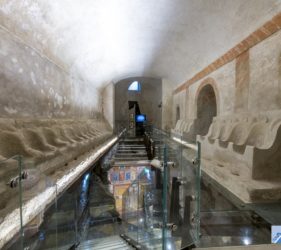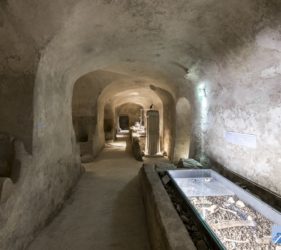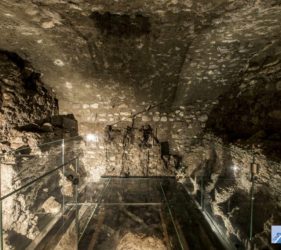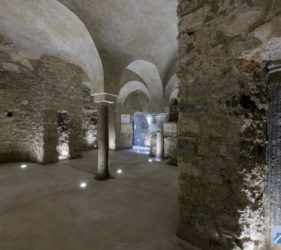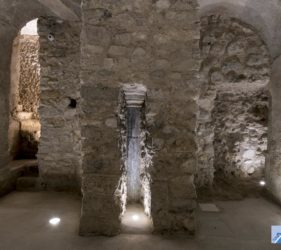Crypts
THE UPPER CRYPT
The hypogeum structure, in part under today’s Oratory and partially on the left aisle of the Upper Church, that has two longitudinal areas. The larger one, of a rectangular form with a lowered barrel vault and an apse (A), is connected through three squared passages to the other environment, narrower and longer (B), which is also vaulted, that ends on the East side with a square hall (C).
Along the perimeter of the main hall – under which, remains of the Roman Villa have been discovered (D)- and on the walls of the passageways, there are 69 lined brick seats used to desiccate the dead, of beautiful craftsmanship in their plastic finishing of the stuccoes lightly coated, there is no comparison in the whole Amalfi territory. The backgrounds of the walls seem to be covered by a light veil of white lime on which we can see swift red colour brushstrokes that form oblique parallel bands and rhombs in the intrados.
An unusual decorative treasure for this type of environment, presumably desired and commissioned, in the first thirty-years of the eighteenth century, by the non-clerical members of the Confraternity of the Monte dei Morti, that had its seat in the upper Oratory.
Of a different tone instead are the simple brick funeral basins placed along the adjacent corridor on the southern side. From here, in the median part, one can access another more ancient cemeterial area (E), placed under the central nave of the church, with which the original trap door is connected, located at the top of the barrel vault. Indeed unique is the distribution on various levels on top of the drain-seats set against the walls, brick built without any finishing, and the presence of a very deep well (F) that opens in the centre of the floor.
MEDIEVAL CRYPT
In ancient times, It is still not quite clear to what purpose, the sacred environment was used for. It is located right under the presbytery of the Upper church dedicated to the Virgin Mary in 1159. The many transformations that the structure underwent in the passing of centuries prevent us from ascertaining if it actually was a Church, or if it functioned as a crypt for the overtop building. The main body has two naves, covered by barrel vaults and separated by arches that discharge on marble columns. Two of them, incorporated in the pillars erected in the early Seventeenth century to hold the great cupola of the Upper church, have been stressed since their latest restoration.
Its planimetric layout shows a tight connection with other Romanesque crypts of the Campania Region and in particular with those of the Cathedral of Salerno, Amalfi, Ravello and Scala.
The eastern wall of the hall has an apse covered by
two small cross vaults in which we can still trace pieces of moulded stucco that look like the rocks: such peculiarity marks the preexistence of an altar – mentioned many times in documents dedicated to the Nativity.
Later the apse space was limited, compared to the naves, by a division wall; inside seated funeral drains were built while, among the above cross vaults, an opening was created (that corresponds to where today’s main Church altar is placed) through which the dead bodies were lowered down. This makes us assume that following the seventeenth century works, the crypt had lost its early liturgical purpose and since then it exclusively carries out a cemeterial function.
Of the ancient decoration remains, only a slight painting trace on the northern wall can be seen, near the access stairway to the Upper church, and a small spiral stucco column set in a small room on the entrance side.
Lina Sabino

